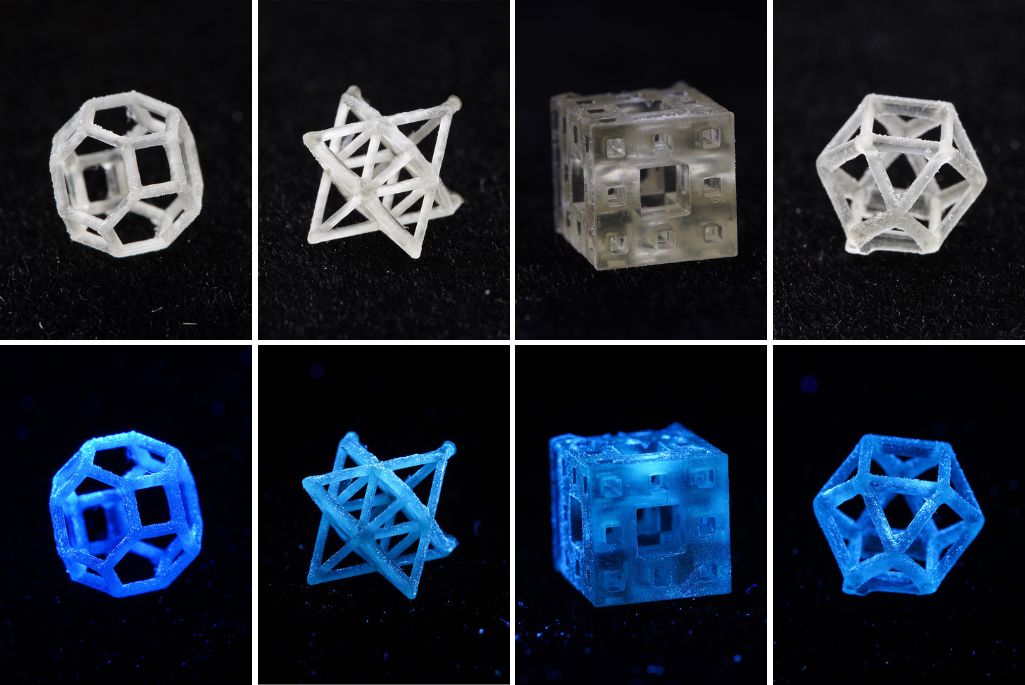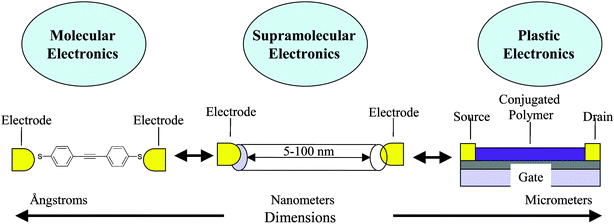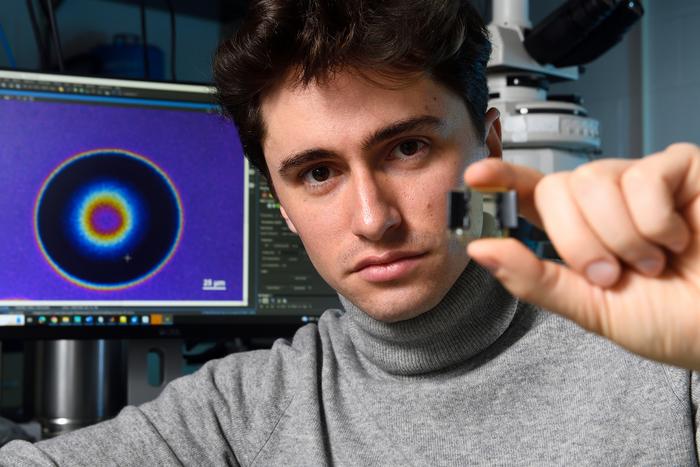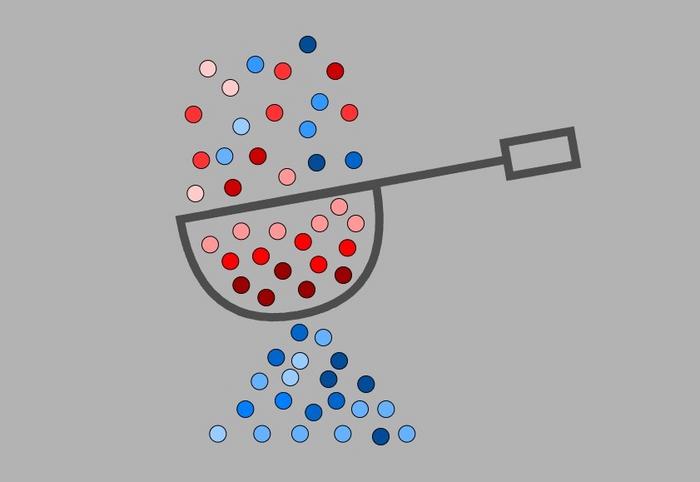
Jenny Nuss/Berkeley Lab. Courtesy of Science
A research team led by Lawrence Berkeley National Laboratory (Berkeley Lab) has developed “supramolecular ink,” a new technology for use in OLED (organic light-emitting diode) displays or other electronic devices. Made of inexpensive, Earth-abundant elements instead of costly scarce metals, supramolecular ink could enable more affordable and environmentally sustainable flat-panel screens and electronic devices.
“By replacing precious metals with Earth-abundant materials, our supramolecular ink technology could be a game changer for the OLED display industry,” said principal investigator Peidong Yang, a faculty senior scientist in Berkeley Lab’s Materials Sciences Division and professor of chemistry and materials science and engineering at UC Berkeley. “What’s even more exciting is that the technology could also extend its reach to organic printable films for the fabrication of wearable devices as well as luminescent art and sculpture,” he added.
“By replacing precious metals with Earth-abundant materials, our supramolecular ink technology could be a game changer for the OLED display industry.”
– Peidong Yang
If you have a relatively new smartphone or flat panel TV, there’s a good chance it features an OLED screen. OLEDs are rapidly expanding in the display market because they are lighter, thinner, use less energy, and have better picture quality than other flat-panel technologies. That’s because OLEDs contain tiny organic molecules that emit light directly, eliminating the need for the extra backlight layer that is found in a liquid crystal display (LCD). However, OLEDs can include rare, expensive metals like iridium.
But with the new material – which the Berkeley Lab team recently described in a new study published in the journal Science – electronics display manufacturers could potentially adopt a cheaper fabrication process.
The new material consists of powders containing hafnium (Hf) and zirconium (Zr) that can be mixed in solution at low temperatures – from room temperature up to around 176 degrees Fahrenheit (80 degrees Celsius) – to form a semiconductor “ink.”
Tiny molecular “building block” structures within the ink self-assemble in solution – a process that the researchers call supramolecular assembly. “Our approach can be compared to building with LEGO blocks,” said Cheng Zhu, the co-first author on the paper and a Ph.D. candidate in materials science and engineering at UC Berkeley. These supramolecular structures enable the material to achieve stable and high-purity synthesis at low temperatures, explained Zhu. He developed the material while working as a research affiliate in Berkeley Lab’s Materials Sciences Division and graduate student researcher in the Peidong Yang group at Berkeley Lab and UC Berkeley.
Spectroscopy experiments at UC Berkeley revealed that the supramolecular ink composites are highly efficient emitters of blue and green light – two signifiers of the material’s potential application as an energy-efficient OLED emitter in electronic displays and 3D printing.
Subsequent optical experiments revealed that the blue- and green-emitting supramolecular ink compounds exhibit what scientists call near-unity quantum efficiency. “This demonstrates their exceptional ability to convert nearly all absorbed light into visible light during the emission process,” Zhu explained.
To demonstrate the material’s color tunability and luminescence as an OLED emitter, the researchers fabricated a thin-film display prototype from the composite ink. In an exciting result, they found that the material is suitable for programmable electronic displays.
“The alphabet movie serves as a compelling example that illustrates the application of emissive thin films like supramolecular ink in the creation of fast-switching displays,” said Zhu.
Additional experiments at UC Berkeley showed that the supramolecular ink is also compatible with 3D printing technologies such as for the design of decorative OLED lighting.
Zhu added that manufacturers could also use the supramolecular ink to fabricate wearable devices or high-tech clothing that illuminates for safety in low-light conditions, or wearable devices that display information through the supramolecular light-emitting structures.
The supramolecular ink is another demonstration from the Peidong Yang lab of new sustainable materials that could enable cost-effective and energy-efficient semiconductor manufacturing. Last year, Yang and his team reported a new “multielement ink” – the first “high-entropy” semiconductor that can be processed at low temperature or room temperature.
With their demonstrated stability and shelf life, the supramolecular ink compounds could also help in the commercial advancement of ionic halide perovskites, a thin-film solar material that the display industry has been eyeing for decades. With their low-temperature synthesis in solution, ionic halide perovskites could potentially enable cheaper manufacturing processes for the manufacturing of displays. But high-performance halide perovskites contain the element lead, which is concerning for the environment and public health. In contrast, the new supramolecular ink – which belongs to the ionic halide perovskite family – offers a lead-free formulation without compromising performance.
Now that they have successfully demonstrated the supramolecular ink’s potential in OLED thin films and 3D-printable electronics, the researchers are now exploring the material’s electroluminescent potential. “This involves a focused and specialized investigation into how well our materials can emit light using electrical excitation,” Zhu said. “This step is essential to understanding our material’s full potential for creating efficient light-emitting devices.”
Original Article: Scientists Advance Affordable, Sustainable Solution for Flat-Panel Displays and Wearable Tech
More from: Lawrence Berkeley National Laboratory | University of California Berkeley
The Latest Updates from Bing News
Go deeper with Bing News on:
Supramolecular ink
- Supramolecular chemistry articles from across Nature Portfolio
Supramolecular chemistry is the study of entities of greater complexity than individual molecules — assemblies of molecules that bond and organize through intermolecular interactions. The design ...
- Chase Ink Cash Review: A Cash-Back Contender for Small Businesses
Earn 5% cash back on office supplies and telecom services and 2% at restaurants and gas stations, up to a limit. With a $0 annual fee and elevated rewards in select categories, this card is a good ...
- Best ink tank printers of 2024
The best ink tank printers are a lot like your standard inkjet printer, but instead of changing a cartridge, you refill the printer's ink reservoirs with bottled ink. Our team of reviewers ...
- Best E Ink tablets in 2024
Slim designs, crisp displays, and intuitive note-taking — find your ideal E Ink tablet with this comprehensive round-up If you're like us, you've also stayed up until the wee hours under the ...
- E Ink displays and its various applications
More recently, Bigme too came up with a color E Ink monitor – the Bigme B251 as well as an all-in-one PC version of the same as well, both featuring a 25.3-inch Kaleido 3 Color e-paper panel ...
Go deeper with Bing News on:
OLED display
- Samsung Expands Its 2024 OLED TV Line-up
The 2024 Samsung OLED 4K TV lineup ranges in size from 42 to 83-inches, priced from $1,399 to $5,399. Editorial Comment: When confronted as to which TV models are incorporating WOLED panels Samsung responded with the following non-response: Samsung OLED ...
- Flanders Scientific's XMP550 QD-OLED HDR Reference Monitor Honored with Prestigious SID 2024 Display Application of the Year Award
Flanders Scientific proudly announces that the XMP550 QD-OLED HDR Reference Monitor has been awarded the Society for Information Display's (SID) 2024 Display Application of the Year Award. This coveted award recognizes outstanding products utilizing novel display technologies that significantly impact the market.
- Cautious Coherent sees OLED display traction
Combined with hefty debt and interest payments for loans used to finance the merger of II-VI and the original Coherent lasers business two years ago, that drop in sales resulted in a net loss of $13.2 million for the latest period.
- Apple debuts new iPad Pro with M4 chip, iPad Air tablets
Apple held its "Let Loose" iPad event Tuesday, unveiling the new iPad Pro, iPad Air and Apple Pencil Pro in what chief executive officer Tim Cook called "the biggest day for iPad since its introduction.
- This 49" Samsung Odyssey G9 OLED monitor is our top choice for gaming. It's now under $1,000
When it comes to computer monitors, we all know there are portable ones, and plenty of run-of-the-mill options that range in size from 22 inches up to 34 inches. And then there are wide monitors. These come in sizes between 34 inches and 38 inches.











